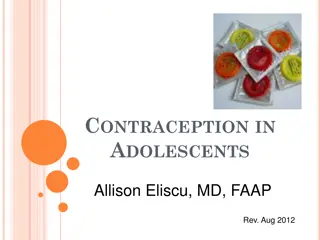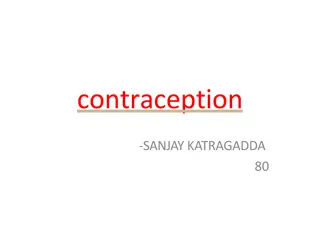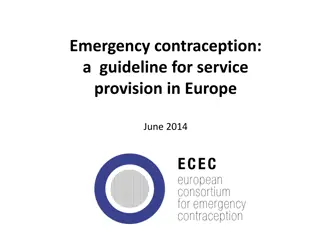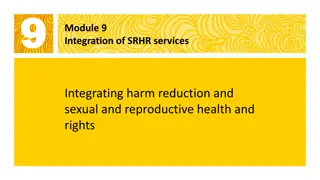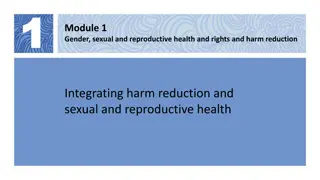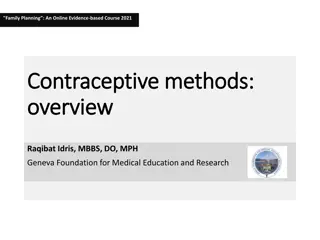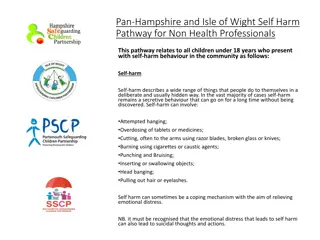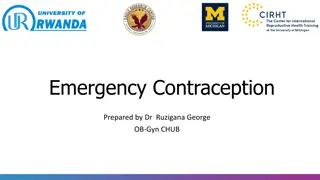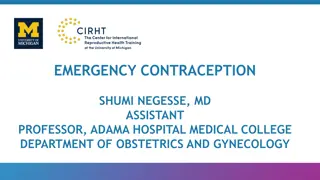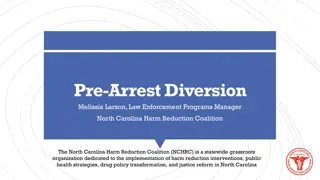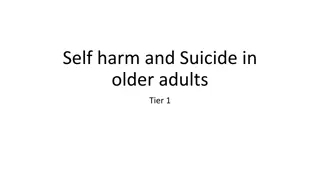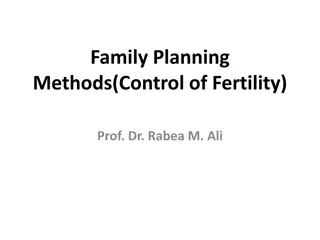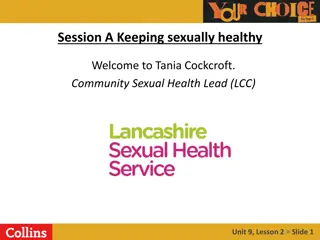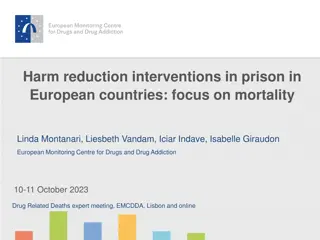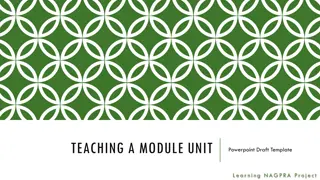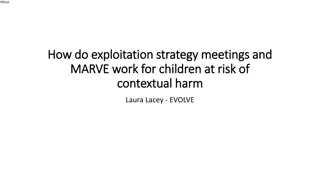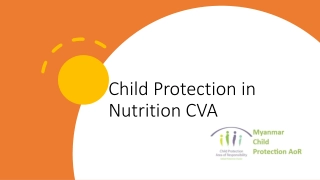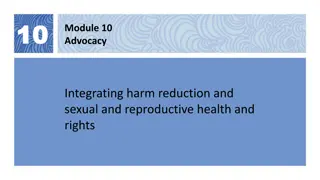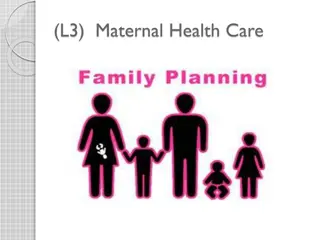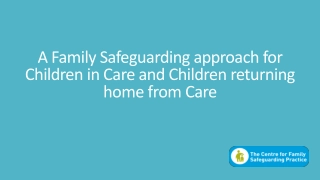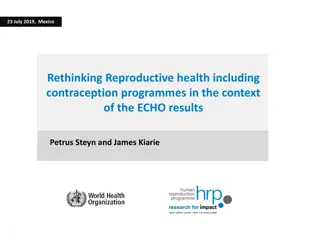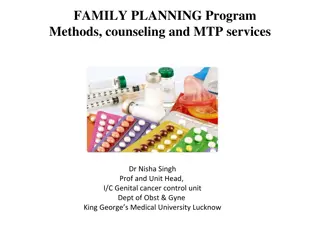Understanding Contraception and Family Planning: Integrating Harm Reduction
Explore misconceptions related to contraception, learn about various contraceptive methods, understand family planning components, provide quality counseling, identify access barriers, and promote informed choices in pregnancy prevention.
Download Presentation

Please find below an Image/Link to download the presentation.
The content on the website is provided AS IS for your information and personal use only. It may not be sold, licensed, or shared on other websites without obtaining consent from the author. Download presentation by click this link. If you encounter any issues during the download, it is possible that the publisher has removed the file from their server.
E N D
Presentation Transcript
4 4 Module 4 Contraception and family planning Integrating harm reduction and sexual and reproductive health and rights
Module 4 Contraception and Family Planning LEARNING OBJECTIVES 1 hour 50 mins To explore misbeliefs associated with contraception and the full range of contraceptive methods To know the main components of family planning and contraceptive services To provide quality counseling on contraception and contraceptive choices to women and gender non-conforming people who use drugs To identify the main barriers to accessing contraception and potential approaches to overcome the barriers
Module 4 Contraception and family planning GAME: 15 mins Find your correct match! 3 contraceptive methods 3 profiles DISCUSSION: 15 mins
Module 4 Contraception and family planning BASIC INFORMATION AND CHOICES There are a lot of beliefs and misconceptions associated with contraceptives methods. For example: Contraceptive methods can cause infertility Women lose libido with hormonal contraception Contraceptive methods can cause birth defects Health professional and harm reduction providers may also share these beliefs. The lack of accurate information will impact and limit people s choices around pregnancy prevention. Every person will have different needs and preferences for contraception. Give them a choice!
Module 4 Contraception and family planning METHODS OF CONTRACEPTION The main effective methods of contraception are: Hormonal methods: implants, pills (progestogen and combined),IUD, injectables Other methods: copper IUD, vasectomy and female sterilisation Barrier methods: internal (female) and external (male) condoms, diaphragm Other methods exist but are less effective and are not under the control of women (for instance the natural method of withdrawal).
Module 4 Contraception and family planning HORMONAL METHODS Small, flexible rods or capsules placed under the skin of the upper arm; contains progestogen hormone only. A healthcare provider must insert and remove it. It can be used for 3 5 years, depending on implant. Irregular vaginal bleeding common but not harmful. Efavirenz-based ART may reduce the effectiveness of the implant. Women living with HIV should receive appropriate counselling to choose the contraceptive method most suited to their situation. Implant It thickens cervical mucous to block sperm and egg from meeting and prevents ovulation. It is highly effective when taken correctly and consistently. Can be used while breastfeeding. Must be taken at the same time each day Progestogen-only pills Contains two hormones (estrogen and progestogen). Prevents the release of eggs from the ovaries (ovulation). Reduces risk of endometrial and ovarian cancer but not other cancers. It is highly effective when taken correctly and consistently. For women who use drugs it may increase the risk of vein problems, such as venous thrombosis or varicose veins. Check with a health professional. Combined contraceptive pills
Module 4 Contraception and family planning OTHER METHODS Small flexible plastic device containing copper sleeves or wire that is inserted into the uterus. Copper component damages sperm and prevents it from meeting the egg. Longer and heavier periods during first months of use are common but not harmful. The copper IUD (Intrauterine device) Permanent contraception to block or cut the vas deferens tubes that carry sperm from the testicles. It keeps sperm out of ejaculated semen. It is highly effective after three months. Does not affect male sexual performance. Voluntary and informed choice is essential. Vasectomy Permanent contraception to block or cut the fallopian tubes. Eggs are blocked from meeting sperm. It is highly effective and informed choice is essential. Female Sterilisation
Module 4 Contraception and family planning BARRIER METHODS The diaphragm and cervical cap are dome-shaped and made of silicone. The cap covers only the cervix. The diaphragm is larger. It lodges behind your pubic bone. You need to use spermicide with the diaphragm or cap to help prevent pregnancy. The diaphragm, cervical cap and sponge are among the least effective forms of birth control. Diaphragm, cervical cap, sponge Made of very thin latex or polyurethane, it fits over an erect penis. Forms a barrier to prevent sperm and egg from meeting. It is effective when used correctly and consistently, with lubricant. Can prevent unintended pregnancy and also protects against sexually transmitted infections, including HIV. External condom (male condom) Made of very thin, transparent, soft polyurethane most are latex-free. It fits loosely inside the vagina. Unlike external condoms, internal condoms can be used even when the penis isn t erect. Can be used for vaginal and anal sex. It is best to insert the internal condom ahead of time, and always before and until vaginal or anal sex is finished. It is effective when used correctly and consistently (with lubricant). It can prevent unintended pregnancy and HIV, and it offers increased protection against SITs by partially covering external genitalia. Internal condom (female condom)
Module 4 Contraception and family planning EMERGENCY CONTRACEPTIVE PILLS Also called the morning after pill. Emergency contraception is not an abortive method as the pill helps avoid conception. Pills are high dose hormonal pills that can be taken up to 72 hours AFTER intercourse but the sooner someone uses emergency contraception the more effective it is. If it contains two pills, take both at the same time. There are no major side effects, but some people may experience vomiting, headache or breast tenderness. If the period does not start in three weeks after taking the pill, check for pregnancy.
Module 4 Contraception and family planning DUAL PROTECTION People who use drugs and their sexual partners must be counselled on dual protection strategies to prevent the transmission of HIV and STIs, as well as to avoid unintended pregnancy. These include: Condoms, plus another contraceptive method Condoms, plus emergency contraception if condom fails Selectively using condoms and another method (for example, using the pill with the main partner, but the pill plus condoms with others).
Module 4 Contraception and family planning METHADONE AND CONTRACEPTION Offering contraception services in conjunction with substance use treatment like methdaone could help the women and gender non-conforming people who use drugs meet their needs for contraception. It can reduce unintended pregnancy. There is no evidence that methadone is incompatible with contraceptive methods. HIV treatment and hormonal contraception There is no evidence of incompatibility between ARVs and hormonal contraceptives.
Module 4 Contraception and family planning FERTILITY/INFERTILITY Infertility is a problem for both men and women, but women are often the ones who are blamed. Infections, some reproductive cancers, abnormalities of the reproductive tract (including blocked fallopian tubes), fibroids or long- term hormone use among trans-women can cause infertility. Environmental and lifestyle factors play also a role. Contraceptives do not cause infertility problems.
Module 4 Contraception and family planning KEY FAMILY PLANNING AND CONTRACEPTIVE SERVICES INCLUDE: Accurate information on a wide range of methods Counselling about the desire to have children Availability of condoms and lubricants and other contraceptives methods Emergency contraception Encouraging shared responsibility between partners Addressing infertility issues and their social consequences
Module 4 Contraception and family planning ROLE PLAY: 20 mins Based on the stories, provide counselling on contraceptive methods. One person plays the role of a women who uses drugs, the other the health professional/harm reduction provider. DEBRIEFING AND DISCUSSION: 10 mins Do you think the counsellor provided accurate information? As a client, do you feel you were given a choice (informed choice)? Why? As a counsellor, did you feel you could respect the choice of the woman? In your opinion, what are the most important skills needed to provide counselling on contraception?
Module 4 Contraception and family planning COUNSELLING SKILLS Importance of providing accurate information Non-judgmental attitudes Active listening Clear communication without technical words use simple language Respect people s right to confidentiality, privacy and informed choice Non-discrimination (regardless of their age, family or social status, sexual behaviour, kind and frequency of drug use, etc.)
Module 4 Contraception and family planning BRAINSTORMING 15 mins What are the main barriers to accessing contraception?
Module 4 Contraception and family planning GROUP EXERCISE: 15 mins What do you need to do to address the barriers? In groups of 5 or 6: Consider the different barriers and propose approaches to overcome them Think of 2 or 3 solutions/actions to improve access to contraception in your organisation/community DISCUSSION: 10 mins
Module 4 Contraception and family planning BARRIERS: APPROACHES TO OVERCOME BARRIERS Lack of access to services and limited choice of methods in the country/area Legal restriction and lack of access to services for under age (under 18 or 16 years old) and unmarried women, etc. Low quality of services (like lack of confidentiality) and negative attitudes of the professionals (judgement), internalised-stigma Gender-based violence Lack of autonomy in making health decisions Lack of meaningful involvement of women and gender non- conforming people who use drugs in service provision Stigmatisation, and fear of stigma and hostility Fear of violence or coercion to adopt long-acting or irreversible methods of contraception Discrepancies between representations of women's sexuality and contraceptive needs Lack of financial means Lack of knowledge, misbeliefs and fear of side effects, perceived health risks Non-recognition of sexuality among certain groups (teenagers, people with disabilities) Political level Advocacy to improve political priorities and funding to SRHR and to improve supply chains Programmatic level Availability of appropriate services, including stocking a wide range of contraceptive methods Emergency pills available with peers on outreach Involvement and training of health professionals and harm reduction providers Support the meaningful involvement of women and gender non- conforming people; support the development of skills and structure in communities and networks Creation of new services, such as individual or couple counselling on contraception Counselling couples on infertility Community level Empowerment of women and gender non-conforming communities; participation of communities Participation and buy-in of men and the wider community Developing education materials on contraception and the importance of individual choice selecting contraceptive methods


